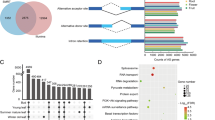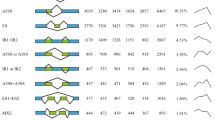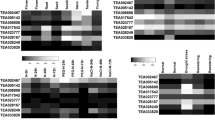Abstract
Alternative splicing (AS) regulates mRNAs at the post-transcriptional level to affect both their amounts and the protein function. However, little is known about the roles of AS in regulation of biosynthesis of amino acids, flavonoids, and volatile compounds in tea plants. In this study, we used Iso-seq and transcriptome deep sequencing (RNA-seq) to identify AS events, and analyzed the expression of respective mRNAs in tea plants under drought (DS), heat stress (HS), and their combination (HD). By RT-PCR, we validated the AS events in nine genes involved in the biosynthesis of amino acids and flavonoids. The genes accumulating AS transcripts under DS, HS, and HD conditions included those encoding for anthocyanidin reductase (ANR), dihydrofavonol-4-reductase-like (DFRA), and chalcone isomerase (CHI). Similarly, genes directly or indirectly involved in the biosynthesis of volatile compounds such as lipoxygenase (LOX), terpenoid/terpene synthase (TPS), and 1-deoxy-D-xylulose 5-phosphate reductoisomerase (DXR) also had AS events. Our study revealed that AS might specifically regulate the biosynthesis of amino acids in tea plants under stressful conditions. Moreover, we suggest that the AS events within the ANR and DFRA transcripts might play an important role in the regulation of flavonoid biosynthesis under DS, HS, and HD conditions. This study improved our understanding of the genetic drivers of the changes in the content of bioactive ingredients of tea plants subjected to abiotic stresses.








Similar content being viewed by others
REFERENCES
Ahmed S., Stepp J.R., Orians C., Timothy G., Corene M., Albert R., Sean C., Dayuan X., Chunlin L., Uchenna U., Sarabeth B., David S., Edward K. 2014. Effects of extreme climate events on tea (Camellia sinensis) functional quality validate indigenous farmer knowledge and sensory preferences in tropical China. PLoS One. 9, e109126. https://doi.org/10.1371/journal.pone.0109126
Das A., Das S., Mondal T.K. 2012. Identification of differentially expressed gene profiles in young roots of tea [Camellia sinensis (L.) O. Kuntze] subjected to drought stress using suppression subtractive hybridization. Plant Mol. Biol. Rep. 30, 1088–1101. https://doi.org/10.1007/s11105-012-0422-x
Li M., Liu J., Zhou Y., Zhou S., Zhang S., Tong H., Zhao A. 2020. Transcriptome and metabolome profiling unveiled mechanisms of tea (Camellia sinensis) quality improvement by moderate drought on pre-harvest shoots. Phytochemistry. 180 (10), 112515. https://doi.org/10.1016/j.phytochem.2020.112515
Cheruiyot E.K., Mumera L.M., Ng’etich W.K., Hassanali A., Wachira F., Wanyoko J.K. 2008. Shoot epicatechin and epigallocatechin contents respond to water stress in tea [Camellia sinensis (L.) O. Kuntze]. Biosci. Biotech. Bioch. 72, 1219–1226. https://doi.org/10.1271/bbb.70698
Upadhyaya H., Dutta B.K., Panda S.K. 2013. Zinc modulates drought-induced biochemical damages in tea [Camellia sinensis (L.) O. Kuntze]. J. Agric. Food Chem. 61, 6660–6670. https://doi.org/10.1021/jf304254z
Wang W., Xin H., Wang M., Ma Q., Wang L., Kaleri N.A., Wang Y., Li X. 2016. Transcriptomic analysis reveals the molecular mechanisms of drought-stress-induced decreases in Camellia sinensis leaf quality. Front. Plant Sci. 7, 385. https://doi.org/10.3389/fpls.2016.00385
Li X., Wei J.P., Ahammed G.J., Zhang L., Li Y., Yan P., Zhang L.P., Han W.Y. 2018. Brassinosteroids attenuate moderate high temperature-caused decline in tea quality by enhancing theanine biosynthesis in Camellia sinensis L. Front. Plant Sci. 9, 1016.https://doi.org/10.3389/fpls.2018.01016
Wang L.Y., Wei K., Jiang Y.W., Cheng H., Zhou J., He W., Zhang C.C. 2011. Seasonal climate effects on flavanols and purine alkaloids of tea (Camellia sinensis L.). Eur. Food Res. Technol. 233, 1049–1055. https://doi.org/10.1007/s00217-011-1588-4
Zheng C., Wang Y., Ding Z.T., Zhao L. 2016. Global transcriptional analysis reveals the complex relationship between tea quality, leaf senescence and the responses to cold-drought combined stress in Camellia sinensis. Front. Plant Sci. 7, 1858. https://doi.org/10.3389/fpls.2016.01858
Qiao D., Yang C., Chen J., Guo Y., Li S. 2019. Comprehensive identification of the full-length transcripts and alternative splicing related to the secondary metabolism pathways in the tea plant (Camellia sinensis). Sci. Rep. 9, 2709. https://doi.org/10.1038/s41598-019-39286-z.
Xu Q., Zhu J.Y., Zhao S., Yan H., Li F., Tai Y., Wan X., Wei C. 2017. Transcriptome profiling using single-molecule direct RNA sequencing approach for in-depth understanding of genes in secondary metabolism pathways of Camellia sinensis. Front. Plant Sci. 8, 1205. https://doi.org/10.3389/fpls.2017.01205
Zhu J., Wang X., Guo L., Xu Q., Zhao S., Li F., Yan X., Liu S., Wei C. 2018. Characterization and alternative splicing profiles of lipoxygenase gene family in tea plant (Camellia sinensis). Plant Cell Physiol. 59 (9), 1765–1781. https://doi.org/10.1093/pcp/pcy091
Ding Y.Q., Wang Y., Qiu C., Qian W., Xie H., Ding Z.T. 2020. Alternative splicing in tea plants was extensively triggered by drought, heat and their combined stresses. Peer J. 8, e8258https://doi.org/10.7717/peerj.8258
Zhu J., Wang X., Xu Q., Zhao S., Tai Y., Wei C. 2018. Global dissection of alternative splicing uncovers transcriptional diversity in tissues and associates with the flavonoid pathway in tea plant (Camellia sinensis). BMC Plant Biol. 18 (1), 266. https://doi.org/10.1186/s12870-018-1497-9
Li Y., Mi X., Zhao S., Zhu J., Guo R., Xia X., Liu L., Liu S., Wei C. 2020. Comprehensive profiling of alternative splicing landscape during cold acclimation in tea plant. BMC Genom. 21, 65. https://doi.org/10.1186/s12864-020-6491-6
Pertea M., Kim D., Pertea G.M., Leek J.T., Salzberg S.L. 2011. Transcript-level expression analysis of RNA-seq experiments with HISAT, StringTie and Ballgown. Nat. Protoc. 11, 1650–1667. https://doi.org/10.1038/nprot.2016.095
Rogers M.F., Thomas J., Reddy A.S., Ben-Hur A. 2012. SpliceGrapher: Detecting patterns of alternative splicing from RNA-Seq data in the context of gene models and EST data. Genome Biol. 13 (1), 1–17. http://genomebiology.com/2012/13/1/R4.
Ding F., Cui P., Wang Z., Zhang S., Ali S., Xiong L. 2014. Genome-wide analysis of alternative splicing of pre-mRNA under salt stress in Arabidopsis. BMC Genom. 15, 431. https://doi.org/10.1186/1471-2164-15-431
Keller M., Hu Y., Mesihovic A., Fragkostefanakis S., Simm S. 2016. Alternative splicing in tomato pollen in response to heat stress. DNA Res. 24, 205–217. https://doi.org/10.1093/dnares/dsw051
Thatcher S.R., Danilevskaya O.N., Meng X., Beatty M., Zastrow-Hayes G., Harris C., Allen B.V., Habben J.E., Li B. 2015. Genome-wide analysis of alternative splicing during development and drought stress in Zea mays. Plant Physiol. 170, 586–599. https://doi.org/10.1104/pp.15.01267
Cui P., Zhang S., Ding F., Ali S., Xiong L. 2014. Dynamic regulation of genome-wide pre-mRNA splicing and stress tolerance by the Sm-like protein LSm5 in Arabidopsis. Genome Biol. 15, R1. https://doi.org/10.1186/gb-2014-15-1-r1
Feng J., Li J., Gao Z., Lu Y., Yu J., Zheng Q., Yan S., Zhang W., He H., Ma L. 2015. SKIP confers osmotic tolerance during salt stress by controlling alternative gene splicing in Arabidopsis. Mol. Plant. 8, 1038–1052. https://doi.org/10.1016/j.molp.2015.01.011
Wang Z., Ji H., Yuan B., Wang S., Su C., Yao B., Zhao H., Li X. 2015. ABA signalling is fine-tuned by antagonistic HAB1 variants. Nat. Commun. 6, 8138. https://doi.org/10.1038/ncomms9138
Park S.Y., Grabau E. 2016. Differential isoform expression and protein localization from alternatively spliced Apetala2 in peanut under drought stress. J. Plant Physiol. 206, 98–102. https://doi.org/10.1016/j.jplph.2016.09.007
Shen Y., Wu X., Liu D., Song S., Liu D., Wang H. 2016. Cold-dependent alternative splicing of a Jumonji C domain-containing gene MtJMJC5 in Medicago truncatula. Biochem. Biophys. Res. Commun. 474, 271–276. https://doi.org/10.1016/j.bbrc.2016.04.062
Marquez Y., Brown J.W.S., Simpson C., Barta A., Kalyna M. 2012. Transcriptome survey reveals increased complexity of the alternative splicing landscape in Arabidopsis. Genome Res. 22, 1184–1195. https://doi.org/10.1101/gr.134106.111
Staiger D., Brown J.W.S. 2013. Alternative splicing at the intersection of biological timing, development, and stress responses. Plant Cell. 25, 3640–3656. https://doi.org/10.1105/tpc.113.113803
Shen Y., Zhou Z., Wang Z., Li W., Fang C., Wu M., Ma Y., Liu T., Kong L.-A., Peng D.-L. 2014. Global dissection of alternative splicing in paleopolyploid soybean. Plant Cell. 26, 996–1008. https://doi.org/10.1105/tpc.114.122739
Walters B., Lum G., Sablok G., Min X.J. 2013. Genome-wide landscape of alternative splicing events in Brachypodium distachyon. DNA Res. 20, 163–171. https://doi.org/10.1093/dnares/dss041
Hatanaka A., Kajiwara T., Sekiya J. 1974. Alcohol dehydrogenanes from thea sinensis seeds. Agric. Biol. Chem. 38, 1835–1844. https://doi.org/10.1271/bbb1961.38.1835
Shen J., Tieman D., Jones J.B., Taylor M.G., Schmelz E., Huffaker A., Bies D., Chen K., Klee H.J. 2014. A 13-lipoxygenase, TomloxC, is essential for synthesis of C5 flavour volatiles in tomato. J. Exp. Bot. 65 (2), 419–428. https://doi.org/10.1093/jxb/ert382
Xu Q., Long C., Mei Y., Huang L., Zhu J., Mi X., Yu Y., Wei C. 2019. Alternative splicing of key genes in LOX pathway involves biosynthesis of volatile fatty acid derivatives in tea plant (Camellia sinensis). J. Agric. Food Chem. 67 (47), 13021–13032. https://doi.org/10.1021/acs.jafc.9b05925
Ren F., Mao H., Liang J., Liu J., Shu K., Wang Q. 2016. Functional characterization of ZmTPS7 reveals a maize τ-cadinol synthase involved in stress response. Planta. 244, 1065–1074. https://doi.org/10.1007/s00425-016-2570-y
Liu G., Liu J., He Z., Wang F., Wei S. 2017. Implementation of CsLIS/NES in linalool biosynthesis involves transcript splicing regulation in Camellia sinensis. Plant Cell Environ. 41, 176–186. https://doi.org/10.1111/pce.13080
Zhang G., Duan C., Wang Y., Wang Y., Leng P. 2013. The expression pattern of β-glucosidase genes (VvBGs) during grape berry maturation and dehydration stress. Plant Growth Regul. 70, 105–114. https://doi.org/10.1007/s10725-012-9782-3
Li Y.Y., Jiang C.J., Wan X.C., Zhang Z.Z., Li D.X. 2005. Purification and partial characterization of β‑glucosidase from fresh leaves of tea plants (Camellia sinensis (L.) O. Kuntze). Acta Biochim. Biophys. Sin. 37, 363–370. https://doi.org/10.1111/j.1745-7270.2005.00053.x
Funding
This research was subsidized by the Significant Application Projects of Agriculture Technology Innovation in Shandong Province (SD2019ZZ010), the Technology System of Modern Agricultural Industry in Shandong Province (SDAIT-19-01) and the Special Foundation for Distinguished Taishan Scholar of Shangdong Province (no. ts201712057), the Livelihood Project of Qingdao City (19-6-1-64-nsh), the Project of Agricultural Science and Technology Fund in Shandong Province (2019LY002, 2019YQ010), the Key Research and Development Project of Shandong Province (2019LYXZ009).
Author information
Authors and Affiliations
Contributions
Yiqian Ding and Kai Fan contributed equally to this article. Writing-Original Draft Preparation, Yiqian Ding; Writing-Review & Editing, Kai Fan and Zhaotang Ding; Methodology, Yu Wang and Liang Chen; Validation, Yiqian Ding and Litao Sun; Data Curation, Xujun Zhu; Software, Wanping Fang and Chen Qiu; Funding Acquisition, Zhaotang Ding.
Corresponding author
Ethics declarations
Conflict of interests. The authors declare that they have no conflicts of interest.
Statement on the welfare of humans or animals. This article does not contain any studies involving humans or animals performed by any of the authors.
Additional information
The text was submitted by the author(s) in English.
Abbreviations: ADH, alcohol dehydrogenase-like; AGXT2, alanine-glyoxylate aminotransferase 2; ALT, alanine transaminase; ANR, anthocyanidin reductase; argB, acetylglutamate kinase; CAD, cinnamyl alcohol dehydrogenase; CCD1, carotenoid cleavage dioxygenase 1; CHI, chalcone isomerase; DFR, dihydrofavonol-4-reductase; DFRA, dihydrofavonol-4-reductase-like; DXR, 1-deoxy-D-xylulose 5-phosphate reductoisomerase; DXS, probable 1-deoxy-D-xylulose-5-phosphate synthase; F3H, flavanone 3-hydroxylase; FLS, flavonol synthase; FPPS, farnesyl pyrophosphate synthase; GAD, glutamate decarboxylase; GDH, glutamate dehydrogenase; GGPPS1, geranylgeranyl diphosphate synthase 1; GOGAT1 (NADH), NADH-glutamate synthase; GS, glutamine synthetase; β‑GLU, beta-glucosidase; IDI, isopentenyl diphosphate isomerase; ilvE, branched-chain-amino-acid aminotransferase; leuA, 2-isopropylmalate synthase A-like; leuB, 3-isopropylmalate dehydrogenase; leuC, 3- isopropylmalate dehydrogenase large subunit; leuD, 3-isopropylmalate dehydrogenase small subunit; LIS, linalool synthase; LOX, lipoxygenase; lysC, aspartokinase; NADP-GDH, NADP-specific glutamate dehydrogenase; NAGS, amino-acid acetyltransferase; P5CDH, delta-1-pyrroline-5-carboxylate dehydrogenase; P5CS, pyrroline-5-carboxylate synthetase; PAL, phenylalanine ammonia-lyase; PMK, phosphomevalonate kinase; SHMT, serine hydroxy-methyltransferase; TES, (−)-alpha-terpineol synthase; thrA, bifunctional aspartokinase/homoserine dehydrogenase 1, chloroplast-like; thrC, threonine synthase, chloroplast-like; TPS, terpenoid/terpene synthase; VAT, acetolactate synthase small subunit.
Supplementary Information
Rights and permissions
About this article
Cite this article
Ding, Y.Q., Fan, K., Wang, Y. et al. Drought and Heat Stress-Mediated Modulation of Alternative Splicing in the Genes Involved in Biosynthesis of Metabolites Related to Tea Quality. Mol Biol 56, 257–268 (2022). https://doi.org/10.1134/S0026893322020042
Received:
Revised:
Accepted:
Published:
Issue Date:
DOI: https://doi.org/10.1134/S0026893322020042




